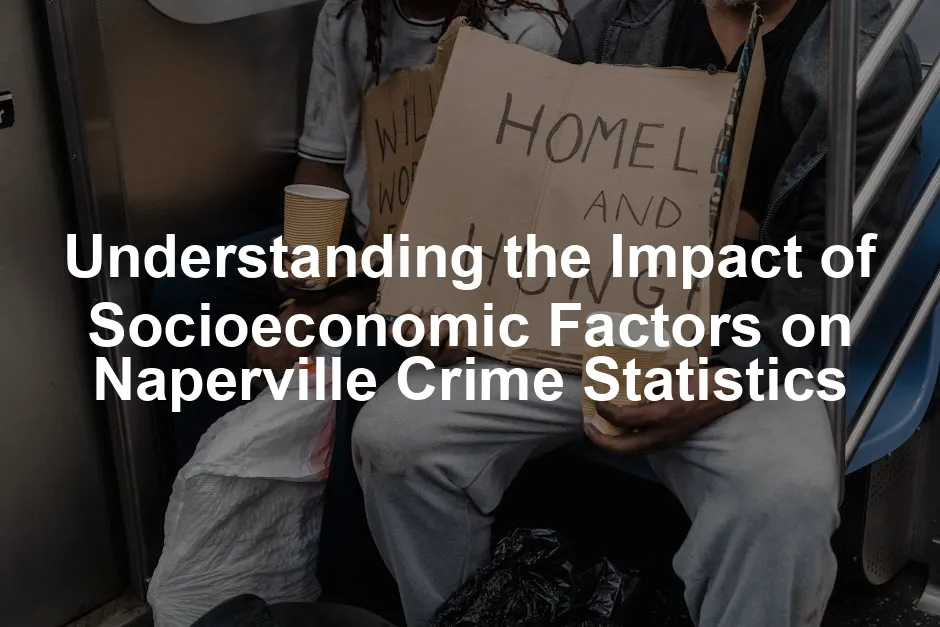Introduction
Crime statistics tell a story, and understanding this narrative requires a closer look at the socioeconomic backdrop. Naperville, a city typically celebrated for its low crime rates, is no exception. It may be hard to believe, but even in affluent communities, socioeconomic factors weave a complex tapestry that can influence crime.
Consider this: Naperville boasts a crime rate lower than 63% of the national average, and the poverty rate stands at a mere 3.8%. Yet, as we peel back the layers, the reality becomes more nuanced. Despite its wealth, Naperville isn’t immune to the struggles faced by neighboring areas. Crime doesn’t discriminate; it can touch anyone, regardless of zip code.
Statistics reveal a curious dichotomy. While violent crimes are significantly low, property crimes have seen a rise. In 2023, theft and burglary incidents nudged upward, leading residents to question their safety. The increase in these property-related offenses often correlates with broader socioeconomic issues, such as unemployment and income inequality.
Anecdotal evidence supports this hypothesis. Local discussions often reflect that crime, particularly property crime, is a desperate response to economic hardship. Imagine a family struggling to make ends meet, facing eviction—the temptation to steal might loom larger in their minds. The complexities of crime in affluent regions, like Naperville, remind us that economic disparity can lurk under the surface, even in seemingly idyllic communities.
Moreover, the relationship between education and crime cannot be ignored. Educational attainment plays a significant role in shaping opportunities and, consequently, impacts crime rates. Residents of Naperville enjoy access to quality education, a privilege that can deter criminal behavior. But what about nearby areas where educational resources are scarce? Education statistics digest can provide insights into how education influences crime.
Speaking of education, if you’re looking for a captivating read that explores how our upbringing shapes our lives, consider Educated by Tara Westover. This memoir is a powerful testament to the transformative power of education, showing how it can elevate individuals from challenging circumstances.
Understanding the role of education in crime rates is crucial. Education statistics digest offers a comprehensive overview of how educational attainment affects crime.
In essence, understanding crime statistics in Naperville is not just about numbers. It’s about recognizing the socioeconomic factors that intertwine with these figures. As we move forward, let’s uncover how poverty, unemployment, and inequality contribute to the crime narrative in this suburban gem.

Summary
As we embark on this exploration of socioeconomic factors shaping crime statistics in Naperville, several key points await our attention. First and foremost, poverty remains a crucial element influencing criminal behavior. Despite Naperville’s relatively low poverty rate, the surrounding areas often face economic challenges. This disparity can lead to increased crime as individuals facing financial hardships may resort to illegal means for survival. Poverty statistics in Texas can help illustrate this issue further.
Poverty is a significant factor in crime rates. Poverty statistics in Texas show how economic struggles can lead to increased crime.
Next, we must examine the connection between unemployment and crime. Naperville’s unemployment rate sits at 2.9%, below the national average of 4.7%. However, even a small percentage of joblessness can create ripples within the community, leading to frustration and desperation that can manifest as crime. For a deeper understanding of the reliability of unemployment statistics, consider exploring What is one reason unemployment statistics are unreliable.
Understanding unemployment’s impact on crime is vital. What is one reason unemployment statistics are unreliable provides insights into this complex issue.
Income inequality further complicates the crime landscape. While Naperville is affluent, nearby regions may struggle with higher inequality. Residents may feel a sense of relative deprivation, which can fuel criminal behavior. The juxtaposition of wealth and poverty creates tension, and those feeling left behind may act out in ways that impact community safety.
Additionally, we will explore theoretical frameworks that help us understand these dynamics. Concepts like strain theory and social disorganization theory will shed light on how socioeconomic factors interplay with crime rates.
Lastly, local community resources play a pivotal role in shaping crime trends. Access to education, healthcare, and employment opportunities can significantly impact crime rates. Naperville’s robust educational system offers a model worth examining, as it fosters opportunities that can deter crime.
With these key points in mind, we are set to dive deeper into the intricate relationship between socioeconomic factors and crime statistics. By understanding these connections, we can foster discussions that lead to effective community strategies and a safer Naperville for all.

Socioeconomic Factors Influencing Crime Rates in Naperville
Poverty and Crime
Poverty often acts as a significant catalyst for criminal behavior. Individuals living in low-income areas may resort to crime as a means of survival. This isn’t just a theory; it’s backed by cold, hard statistics. Naperville’s poverty rate sits at an impressive 3.8%, starkly contrasting with the national average of 15.1%. This means that while the vast majority of Naperville residents enjoy financial stability, a notable portion of the population in nearby areas faces severe economic hardships.
Consider the dynamics in lower-income neighborhoods. Crime rates tend to soar in these areas, where options for legitimate employment dwindle. Take theft, for example. In communities with high poverty rates, stealing can seem like the only viable option to make ends meet. However, in Naperville, where opportunities abound, crime rates remain relatively low. It’s a classic case of how socioeconomic conditions directly influence criminal behavior.
Moreover, property crimes, such as burglary and vandalism, have been reported more frequently in low-income neighborhoods. If a family struggles to pay the bills, the temptation to commit theft can loom larger. This reality becomes even clearer when you juxtapose local crime statistics with those from economically disadvantaged areas. In Naperville, the crime narrative is vastly different. Residents enjoy a sense of security, largely due to the community’s wealth and resources.
Interestingly, Naperville’s police reports indicate that while property crimes have seen a slight uptick, the overall crime rate remains significantly lower than the national average. This suggests a direct correlation between economic opportunities and crime rates. Simply put, when people have access to jobs, education, and resources, they’re less likely to engage in criminal activities.
Speaking of resources, if you’re looking to improve your home cooking and meal prep, you might want to check out the Instant Pot Duo 7-in-1 Electric Pressure Cooker. This kitchen gadget not only saves time but also encourages home-cooked meals, which can be a great way to bring families together and reduce stress.

Unemployment and Crime
Unemployment rates offer another lens through which we can understand crime. Naperville’s unemployment rate stands at a low 2.9%, compared to the national average of 4.7%. This disparity highlights another crucial aspect of crime prevention. When individuals are employed, they have a sense of purpose and financial stability, reducing the likelihood of turning to crime.
Joblessness, on the other hand, can create a breeding ground for criminal behavior. Without a steady income, individuals may feel desperate and turn to illegal activities to survive. In areas where unemployment is high, crime rates often follow suit. The connection is clear: as job opportunities diminish, frustration and hopelessness increase, leading some individuals down a criminal path.
In Naperville, the low unemployment rate is a testament to the community’s economic vitality. Residents have access to a variety of job opportunities, from retail to high-tech industries. This stability fosters a sense of community and safety. When people are gainfully employed, they’re less likely to engage in criminal activities.
Moreover, the implications of joblessness extend beyond individual choices. High unemployment rates in surrounding areas can have a ripple effect, impacting Naperville’s crime statistics. Although Naperville is relatively insulated from these issues, the interconnectedness of socioeconomic factors means that crime can still creep into even the most affluent neighborhoods.
To keep your mind sharp and stay informed about these socioeconomic dynamics, consider reading Freakonomics: A Rogue Economist Explores the Hidden Side of Everything. This book offers a unique perspective on the incentives that drive human behavior, which can be particularly enlightening when examining crime statistics.
In summary, understanding the impact of socioeconomic factors on crime in Naperville is crucial. Poverty and unemployment are not just numbers; they represent real challenges faced by many individuals. By addressing these root causes, communities can work towards reducing crime and fostering a safer environment for everyone.

Income Inequality
Income inequality refers to the uneven distribution of income within a population. This disparity often leads to various social issues, including crime. When a community experiences significant income gaps, feelings of relative deprivation can arise. Individuals may perceive themselves as lacking compared to those who are more affluent. This feeling can spur frustration and, in some cases, lead to criminal behavior.
Take Naperville as an example. Known for its wealth, the city often stands in stark contrast to nearby areas grappling with economic challenges. While Naperville boasts a vibrant economy and a high standard of living, neighboring communities may struggle with high poverty rates and limited opportunities. This juxtaposition can create tension. Residents in less affluent areas may feel marginalized, prompting some to engage in criminal activities as a misguided means to improve their circumstances.
For instance, a family in a neighboring town facing eviction may view theft as their only option. This desperate mindset highlights how relative deprivation can push individuals toward crime. In contrast, Naperville’s affluence creates a buffer against such pressures. The wealth enjoyed by its residents often translates into better access to resources, education, and community support, further reducing the likelihood of criminal behavior.
Yet, the impact of income inequality on crime is not just theoretical. Numerous studies show a direct correlation between income gaps and crime rates. As we assess Naperville’s crime statistics, it’s vital to consider these socioeconomic factors. The city’s low crime rate is commendable, but it masks the reality that nearby areas continue to struggle under the weight of inequality.
If you’re curious about the psychological impacts of trauma related to crime and inequality, you might find The Body Keeps the Score an enlightening read. It provides insight into how trauma affects our mental health and behaviors, which can be particularly relevant in discussions about crime.

Theoretical Perspectives on Crime and Socioeconomic Factors
Strain Theory
Strain theory posits that individuals experience pressure when they cannot achieve socially accepted goals through legitimate means. This pressure often leads to frustration and may result in criminal behavior. In economically disadvantaged communities, opportunities for legitimate success are scarce. As aspirations clash with reality, some individuals may resort to crime as an alternative pathway.
In Naperville, the theory sheds light on why those in lower-income areas might engage in illegal activities. The feeling of being trapped in a cycle of poverty can be overwhelming. When individuals see others achieving success, yet feel barred from similar opportunities, the strain can become unbearable. The solution appears simple: commit a crime to get ahead.

Social Disorganization Theory
Social disorganization theory provides another lens through which we can understand crime in communities like Naperville. This theory suggests that high levels of poverty and residential instability contribute to increased crime rates. Communities lacking resources, stable housing, and social cohesion struggle to maintain order.
In Naperville, the contrast is evident. The city boasts strong community resources, well-funded schools, and active local organizations. These factors play a crucial role in crime prevention. When residents feel connected and invested in their community, they are more likely to report suspicious activities and work together to maintain safety.
Conversely, neighborhoods facing economic struggles often lack these protective factors. The absence of strong community ties can lead to increased criminal activity. Understanding these dynamics emphasizes the importance of nurturing community resources in crime prevention efforts.

Economic Deprivation Theory
Economic deprivation can have profound psychological effects. Individuals facing financial struggles often experience stress, anxiety, and a sense of hopelessness. This emotional turmoil can lead to maladaptive coping strategies, including criminal behavior. After all, when survival becomes a daily battle, the line between right and wrong can blur.
In communities where economic opportunities are scarce, crime rates often rise. People may resort to theft or drug dealing as a means of making ends meet. This trend is evident in areas surrounding Naperville, where those experiencing economic hardship may view crime as a viable option for financial stability. In contrast, Naperville’s wealth shields it from these extremes, but the ripple effects from nearby areas cannot be ignored.

The Role of Education and Family Structure
Education
Education is a significant predictor of crime rates. Higher educational attainment typically correlates with lower crime rates. Individuals with a solid education often have better job prospects, reducing the likelihood of engaging in criminal activities. In Naperville, the education system is robust, offering numerous resources and opportunities for students.
Local initiatives aim to enhance educational access and quality. Programs focusing on after-school tutoring, scholarships, and mentorship create pathways for success. The Naperville Education Foundation, for example, supports innovative projects that enrich student learning. These efforts not only boost academic achievement but also contribute to a safer community by giving students positive alternatives to crime.
Statistics reflect this relationship. Areas with lower educational attainment often struggle with higher crime rates. Conversely, communities like Naperville, with a strong focus on education, see reduced criminal activity. By investing in education, Naperville is not just nurturing its youth; it’s fortifying its community against crime.
If you’re interested in enhancing your own understanding of psychological principles affecting behavior, check out The Social Animal. This book provides insights into human behavior and social psychology, which are essential for understanding societal issues like crime.

Family Dynamics
Family structure plays a crucial role in shaping an individual’s propensity for criminal behavior. Stable family environments often lead to better emotional and social outcomes. In Naperville, a majority of families enjoy a stable structure, which can correlate with lower crime rates.
Statistics show that children raised in two-parent households are generally less likely to engage in criminal activities. In Naperville, approximately 75% of households are intact families, providing a nurturing environment for children. This family stability contributes to the overall safety of the community.
However, it’s essential to recognize that not all families in Naperville exist in such harmony. The city, like many others, has households facing challenges. When families struggle, children may lack the support they need, leading to risky behaviors. Communities must focus on strengthening family ties and providing support systems to bolster stability. Programs offering parenting classes and family counseling can make a difference.
In conclusion, the interplay between education, family dynamics, and socioeconomic factors significantly affects crime rates in Naperville. By fostering educational initiatives and supporting families, the community can continue to lower crime rates and enhance overall safety. Investing in these areas not only benefits individuals but also strengthens the fabric of the entire community.

Community Resources and Crime Prevention
Access to Resources
Healthcare, mental health services, and community programs are vital elements in reducing crime rates. In Naperville, access to these resources is not just a luxury; it’s a necessity. When individuals have access to quality healthcare, their overall well-being improves. This, in turn, lowers the likelihood of engaging in criminal behavior. Mental health services are particularly crucial. A person struggling with mental health issues may resort to crime as a coping mechanism, especially if support systems are lacking.
Naperville boasts a wealth of community programs designed to uplift residents. Take, for instance, the numerous local initiatives aimed at providing job training and educational opportunities. These programs equip individuals with skills and knowledge necessary for stable employment. With a poverty rate of 3.8% compared to the national average of 15.1%, Naperville’s resources support a populace less likely to turn to crime.
Consider the role of youth programs in crime prevention. Local organizations offer after-school activities that engage young minds and keep them away from streets that might otherwise lead to trouble. By providing safe spaces for children and teenagers, these resources mitigate potential criminal behavior before it starts. When kids feel valued and have a sense of belonging, they’re less likely to make poor choices.
Furthermore, community resources don’t just address immediate needs. They foster long-term changes in the social fabric of Naperville. With a well-supported population, the community as a whole exhibits resilience against crime. In essence, when residents have access to essential services, it creates a ripple effect that contributes to lower crime rates.
To enhance your home environment, you might also consider investing in a Home First Aid Kit. It’s always a good idea to be prepared for emergencies, and having a well-stocked first aid kit can make a significant difference in critical moments.

Community Engagement
Community engagement is like the secret sauce in Naperville’s crime prevention recipe. Local initiatives encourage residents to take an active role in enhancing their neighborhoods. One excellent example is the Naperville Police Department’s outreach programs. These initiatives promote awareness and foster relationships between officers and residents. When people feel connected to their local law enforcement, they’re more likely to report suspicious activities.
Another shining example is the neighborhood watch programs. These grassroots efforts empower residents to look out for one another. When a community collectively decides to monitor activities, it sends a strong message to would-be offenders: “We’re watching!” Such vigilance can deter crime, making Naperville a less appealing target for criminal activities.
Moreover, community events like clean-up days and block parties promote unity. When residents come together to improve their surroundings, they cultivate a sense of pride and responsibility. This collective engagement can significantly reduce crime rates. After all, when people care about their community, they are less likely to engage in disruptive behaviors.
Success stories abound. Take the incident when a local organization launched a mentorship program for at-risk youth. The program connected young people with positive role models, steering them away from crime and toward constructive paths. Similar initiatives have shown marked reductions in crime rates, demonstrating the profound impact of community involvement.
In summary, Naperville’s commitment to community engagement is a cornerstone of its low crime rates. By fostering connections among residents and law enforcement, the city cultivates an environment where crime cannot thrive. When individuals participate in their community, they create a safer, more resilient Naperville for all.

Conclusion
In wrapping up our exploration of socioeconomic factors and crime rates, it’s crucial to understand their interconnectedness. Access to resources and community engagement play pivotal roles in shaping crime statistics. Naperville’s success is not merely a product of its affluence but a reflection of its proactive approach to addressing underlying issues.
The relationship between socioeconomic conditions and crime is intricate. Poverty, unemployment, and income inequality are significant influencers. Even a city as prosperous as Naperville must remain vigilant. By prioritizing access to healthcare and mental health services, the community can mitigate risks that lead to crime.
Ultimately, fostering community involvement is equally vital. Engaged residents contribute to a culture of safety and support. As we consider the lessons from Naperville, let’s reflect on our own communities. Addressing socioeconomic factors and encouraging engagement can lead to safer, more cohesive neighborhoods. It’s time to ask ourselves: What can we do to improve our communities and reduce crime? Together, we can create environments where everyone thrives.

FAQs
What are the main socioeconomic factors affecting crime rates?
Poverty, unemployment, and education are the primary socioeconomic factors influencing crime rates. Areas with high poverty levels often experience increased crime due to limited opportunities. Unemployment creates financial strain, pushing individuals toward illegal activities. Education plays a crucial role in providing pathways to legitimate employment, reducing crime likelihood.
How does Naperville compare to other cities in terms of crime rates?
Naperville’s crime rates are remarkably lower than national averages. The city boasts a total crime rate 63% lower than the national average. Violent crime is 86% lower, while property crime is 58% lower. This data highlights Naperville’s effectiveness in managing crime through socioeconomic strategies.
What can be done to reduce crime in affluent communities?
Reducing crime in affluent communities requires engaging residents and investing in education and resources. Initiatives that promote community involvement and provide support services can enhance safety. Creating programs focused on mentorship and job training can also divert at-risk individuals from criminal behavior.
How do local policies impact crime statistics?
Local policies significantly influence crime rates. Effective law enforcement strategies and community-oriented policing foster trust and communication between police and residents. Policies that prioritize mental health resources and educational opportunities are crucial in addressing the root causes of crime.
Where can I find more information on Naperville crime statistics?
For more details on crime statistics in Naperville, visit the Naperville Police Department’s website. They provide annual reports and interactive maps detailing crime data. Local community safety initiatives can also be found through the city’s official website, promoting awareness and engagement among residents.
Please let us know what you think about our content by leaving a comment down belove!
Thank you for reading till here 🙂
All images from Pexels




